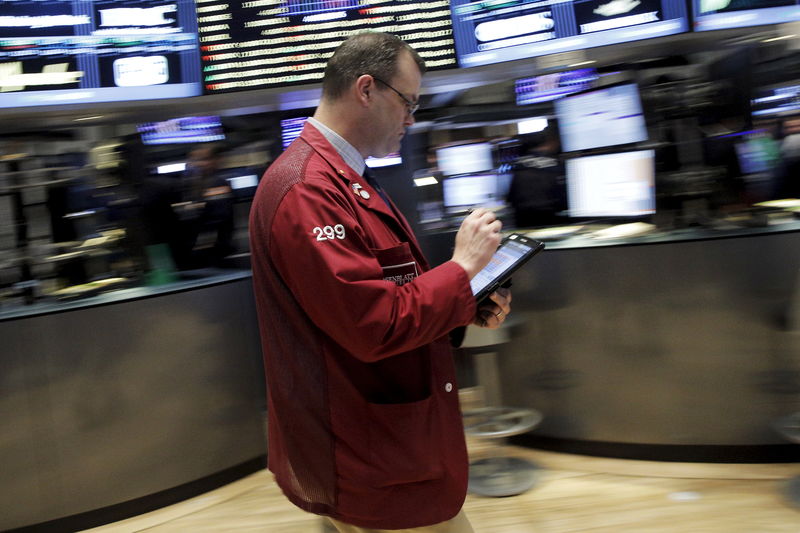Investing.com - Here are the top five things you need to know in financial markets on Monday, April 2:
1. Trade spat between U.S. and China continues in high gear
Market participants continued to focus on the escalation of trade tensions at the beginning of the week. China announced Monday that it is increasing tariffs by up to 25% on certain U.S. imports in response to U.S. duties on imports of aluminum and steel.
The move intensified trade tensions between the world's two largest economies, which investors fear could escalate into a full blown trade war and deal a blow to the global economy.
The Trump administration this week will unveil the list of Chinese imports targeted for U.S. tariffs to punish Beijing over technology transfer policies, a move expected to further intensify the strain between the world's two largest economies.
The list of $50 billion to $60 billion worth of annual imports is expected to target "largely high-technology" products and it may be more than two months before tariffs take effect, administration officials have said.
2. Global stocks drop over trade worries
U.S. futures pointed to a lower open on Monday after the long Easter weekend as investors adopted a risk-off stance to face off against escalating trade tensions. At 5:50AM ET (9:50GMT), the blue-chip Dow futures fell 75 points, or 0.31%, S&P 500 futures lost 7 points, or 0.26%, while the Nasdaq 100 futures traded down 38 points, or 0.58%.
Elsewhere, European stock markets remained closed for the Easter Monday holiday.
In Asia, Hong Kong’s stock market was also closed, while both Japan’s Nikkei 225 and China’s Shanghai Composite closed with slight losses in the face of trade tensions.
3. Oil gains support from drop in U.S. production
Oil prices rose on Monday, buoyed by a decline in U.S. oil production. Energy services firm Baker Hughes on Thursday reported that the number of active U.S. rigs drilling for oil fell by seven to 797. That was the first decline in U.S. drilling activity in three weeks last week. The closely watched report was published one day earlier than usual, due to the Good Friday holiday.
The data eased concerns that booming U.S. shale oil production could potentially derail efforts by the Organization of the Petroleum Exporting Countries’ to end a supply glut.
Oil was also supported by speculation that tensions between the U.S. and Iran may lead to sanctions that would hinder Iranian oil exports. Recent criticism by U.S. President Donald Trump of the 2015 international agreement to curb Iran’s nuclear program has increased expectations that the U.S. may pull out of the deal and re-impose prior sanctions.
U.S. crude oil futures rose 0.35% to $65.17 at 5:51AM ET (9:51GMT), while Brent oil traded up 0.55% to $69.72.
4. Focus on U.S. manufacturing after downbeat data in Asia
Ahead of Friday’s release of nonfarm payrolls, investors will keep watch Monday on the state of the U.S. manufacturing sector. The Institute of Supply Management will release its manufacturing purchasing managers’ index (PMI) at 10:00AM ET (14:00GMT) with expectations pointing to a slight drop from 60.8 to 60.1.
The data stateside will arrive after a report showed that China’s factory growth slowed to a four-month low. The Caixin/Markit manufacturing PMI unexpectedly fell to 51.0 in March from February's 51.6, missing expectations for a slight uptick to 51.7.
In Japan, business sentiment worsened for the first time in two years in the three months to March. An index measuring big manufacturers' confidence fell by 2 points to plus 24 in March, the Bank of Japan's quarterly "Tankan" survey showed.
Non-manufacturers' sentiment worsened by 2 points to 23, deteriorating for the first time in six quarters.
5. Gold receives safe haven bid and support from weakening dollar
Gold moved higher on Monday as escalating trade tensions drove investors to the safe haven precious medal and the continued slide in the dollar delivered support.
Investors seek out gold as a store of value during times of political or economic uncertainty, while a weaker dollar makes dollar-denominated commodities cheaper for holders of other currencies.
Gold futures for June delivery on the Comex division of the New York Mercantile Exchange gained $8.10, or around 0.6%, to trade at $1,335.40 by 5:51AM ET (9:51GMT), while the U.S. dollar index, which measures the greenback’s strength against a trade-weighted basket of six major currencies, fell 0.21% at 89.56.
As investors keep an eye on the greenback, they will also pay close attention to comments from a few Federal Reserve speakers this week for insights into the outlook for monetary policy.
Topping the agenda will be remarks from Fed chairman Jerome Powell, who is scheduled to speak about the economic outlook at the Economic Club of Chicago on Friday at 1:30PM ET (17:30GMT).
Speeches from Minnesota Fed president Neel Kashkari, St. Louis Fed chief James Bullard, Fed governor Lael Brainard, Cleveland Fed president Loretta Mester, Atlanta Fed boss Raphael Bostic and Chicago Fed president Charles Evans are also on the agenda.
